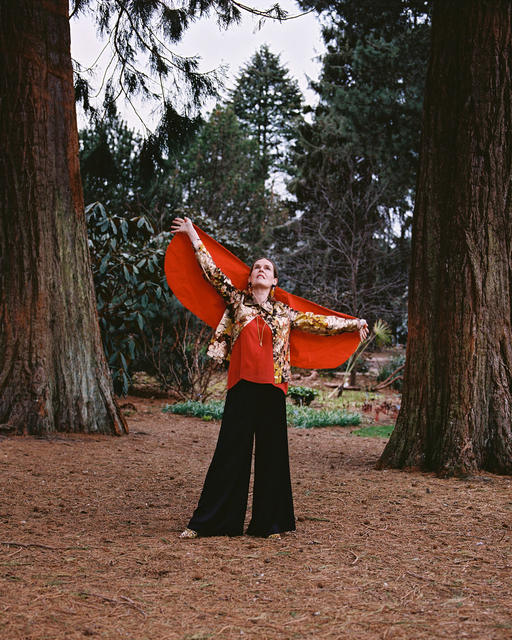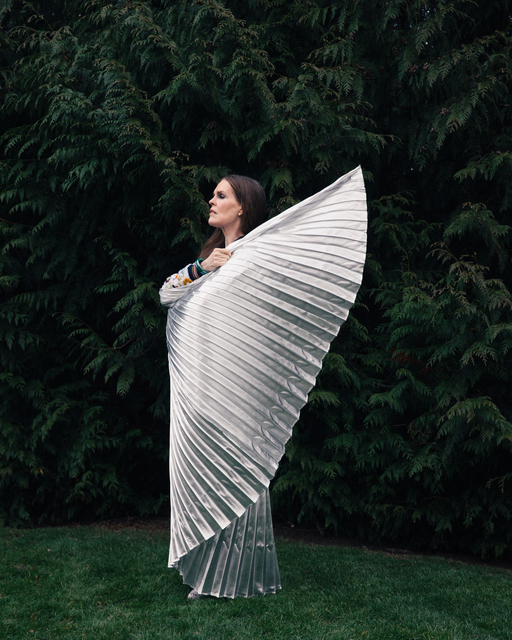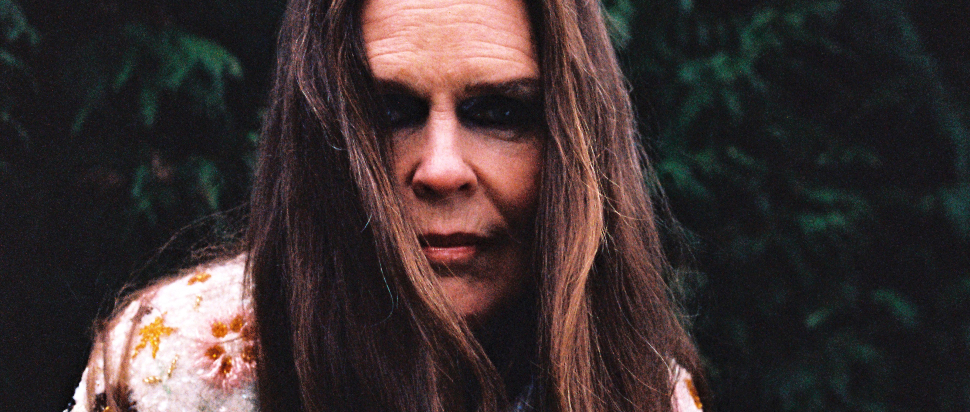Linder Sterling's Alternative Aristocracy
Ahead of her first retrospective in Scotland, the feminist artist Linder Sterling reveals how she practises punk in a dead-end world
At the time of writing this, the feminist-punk artist Linder Sterling is taking a scalpel to her source material to conjure a photomontage for The Skinny's May 2025 cover. In what is shaping up to be a Scottish summer for the artist, she is also preparing for her first retrospective in Scotland, Linder: Danger Came Smiling, and a two-part performance specially commissioned by Edinburgh Art Festival (EAF) and Mount Stuart Trust. It may take her hours, days even, to sift through the Playboy magazines of dead husbands donated to her by crafty widows, or the vintage photography books she rummages for in charity shops (the more aged the spine, the better). According to our brief, Linder is forbidden from cutting and pasting an image of a penis above a 45-degree angle, but otherwise, she doesn't know, and we don't know, what she'll end up with. The muse of her studio is there to guide her.
This photomontage joins Linder’s revolutionary body of work that spans five decades. Born to a working-class family in Liverpool in 1954, Linder experimented with art at the Manchester Polytechnic in the mid-1970s. She was the first in her family to continue school beyond the age of 14 and did so at a time of astronomical economic recession that saw working-class youth face mass unemployment. Worryingly, fascism (via the National Front) and, fortunately, feminism (via the Women's Liberation Movement) were simultaneously on the rise, causing an intensity of political division that created a perfect storm for the punk explosion.
Circa the year 1977, Linder became a punk – or rather, that was the title she was given. “Suddenly, [the tabloid media] was using this four-letter word to describe us all,” she reflects, urging me to look up the etymological root of the word. She is obsessed with language to an infectious degree. It’s a slur from North American English, meaning ‘a worthless person’. Instead, Linder understood her – and her contemporaries’ – actions as an expression of frustration with injustice and the government. “We were seen as freaks”, Linder reflects, adding that it wasn’t safe to dress as a punk, particularly for a woman, as aggressors actively targeted members of the alternative subculture.
It was in 1977 that Linder made the photomontage that she is perhaps best known for in popular visual culture. Gracing the vinyl front cover of the Buzzcocks’ single Orgasm Addict is a naked woman with gritted-teeth smiles for nipples and an iron for a head. All at once, the photocollage rips apart the cultural objectification of women and the patriarchal division of labour. That same year, punk’s frenetic energy and DIY ethos was catching on. X-Ray Spex, headed up by frontwoman Poly Styrene, released their debut single, Oh Bondage, Up Yours!, its lyrics a visceral protest of capitalist materialism. Meanwhile, writer Lucy Toothpaste published the first issue of JOLT, a fanzine dedicated to fighting racism and fascism. Photojournalist Caroline Coon captured the zeitgeist on camera, collaborating with the likes of the Sex Pistols, The Clash, the Damned and the Slits.
Through her anarchistic photomontage technique that evolved from Dada, Linder defies any clean-cut binaries as she annihilates, mocks, and transmogrifies her source material. No definitive answer to the perennial debate of whether pornography is empowering or disempowering for women can be found by searching through the layers of her photomontages. But she does offer cutting relief in the face of constrictive ideals of femininity and hetero-patriarchal boredom; in her mish-mashed world, women stab forks in their eyes as a man dotes on them, and wank about someone else while he sleeps blissfully unaware.

Linder Sterling. Image: Charlotte Cullen.
Through cut and paste, Linder disrupts the digital tools built for and by the patriarchy, creating an “alternative aristocracy”. For the first leg of her 2025 touring exhibition, Linder: Danger Came Smiling, at London’s Hayward Gallery, she decided to “deep fake” herself before anyone else could. Stripping away the threat posed by incels and transforming the technique for feminist ends, she found inspiration in Salvador Dali’s Shirley Temple, The Youngest, Most Sacred Monster of the Cinema in Her Time (1939). Through collage, Dali turned Temple into a sphinx to satirise the sexualisation of child stars in Hollywood. To create The Most Sacred Monster of the Photomontage of Her Time (2025), Linder used a 1968 Playboy centrefold of Miss July for her sphinx’s body, and a self-portrait crowned with scissors, spikes, and a fork for the head. The red-hot photomontage is on fire from anger; there is no messing with the Linder-sphinx.
Just as Linder activates the poised, sexual bodies of porn magazines with paradoxical objects, she is drawn to the medium of performance to provoke an emotive response in the beholder. This has been at the forefront of her mind as she gears up for the retrospective’s second stop at the Royal Botanic Garden Edinburgh (RBGE). The exhibition is adapted to emphasise the flora and fauna of Linder’s practice, where roses exaggerate nipples, irises shield a lesbian threesome from the male gaze, and an orchid becomes a larger-than-life phallus. “Visitors can experience Mother Nature in the round alongside my foregrounding of photographs of her blossoms,” Linder explains, adding that botanists have identified plants to feature in her photomontages on display. Alongside, Linder will premiere A kind of glamour about me at Mount Stuart on the Isle of Bute on 14 June before kicking off Edinburgh Art Festival (EAF) with the performance at RBGE on 7 August.
The performance is titled after a quote from novelist and poet Sir Walter Scott’s diary: “There is a kind of glamour about me, which sometimes makes me read dates, etc, in the proof-sheets, not as they actually do stand, but as they ought to stand. I wonder if a pill of holy trefoil would dispel this fascination.” Scott acknowledges the flaws of his editorial power, confessing that he is overcome by a “magical delusion” while too close to his own writing. Linder argues that Scott’s introduction of ‘glamour’ into the English language is more than skin deep; in Scotland, glamour is “far more rebellious, far more shocking than punk” because of its medieval occult meaning. For her, “glamour and punk [are] bedfellows”. She elaborates, describing her experience of presenting punk through central Manchester in the movement’s early days: “We didn’t look pretty, we didn’t look nice, we didn’t look glamorous… But we all felt deeply, deeply glamorous. Glamour had nothing to do with beauty.”
Under glamour’s magical spell, Linder was the frontwoman of Ludus, a punk band that influenced the likes of Morrissey. In 1982, at Manchester’s Haçienda club on a stage strewn with tampons, she performed in a dress made of raw meat and revealed a dildo, stunning the audience to silence in her wake. By contrast, A kind of glamour about me offers the audience “elegance, comfort, and community”. Given the daily shock of world events – genocides, the back-pedalling of human rights, Trump’s authoritarian populism – Linder’s approach to shock has shifted. While collaboratively and tenderly workshopping the performance, it dawned on her that practicing empathy and kindness “felt as shocking now as wearing a meat dress did back in the day”. Through performance, she offers us a “salve for the soul”.

Linder Sterling. Image: Charlotte Cullen.
A kind of glamour about me, and its multitude of intriguing influences, are currently ticking away in Linder’s psyche. Transgressing the boundaries between ‘high’ (ancient mythology) and ‘low’ (social media) culture, Linder is particularly interested in the mythic resonance of human-to-tree transformation as an allegory for the state of the feminine psyche. Improvisation is key to her performances as she collaborates with a cohort of extraordinary creatives who are comfortable not knowing what will unfold on the day. Among the collaborators are a troupe of dancers led by boundary-pushing choreographer Holly Blakey, composer and musician Maxwell Sterling (Linder’s son), and fashion designer Ashish Gupta, known for his sequin and slogan-adorning pieces that blend glamour and political commentary.
Both performances respond to the historical and natural context of their settings. At Mount Stuart, a Neo-Gothic mansion, the performance will take place in the Marble Hall, under the star-studded ceiling, as the sun refracts through stained glass depictions of the zodiac. By contrast, at RBGE, the performers and audience will gather outside, on the Garden's Oak Lawn. At present, bears from Scotland’s queer communities are being recruited to perform, wryly referencing the children’s song Teddy Bear’s Picnic, while foregrounding non-normative gender expressions of masculinity in LGBTQ+ culture.
Sometimes when I ask Linder a question, she laughs like Medusa. Other times, she dissects the current state of the world like she does her source material, ready to assemble a new order out of a fragmentary mess. “After 70 years on the planet, this is the worst yet,” she despairs, referencing the rallying cries of the far right and the toxic positivity of social media in the same breath. As we live through uncannily similar circumstances that made way for punk expression, Linder challenges us to “become the aristocrats of our own destiny,” even though “our nervous systems might be screaming at us” and we haven’t a penny in our pocket. Who knows – we might find that punk impulse for change, community, and a collective voice through A kind of glamour about me.
Linder: Danger Came Smiling, Royal Botanic Garden Edinburgh, 23 May-19 Oct, free
A kind of glamour about me, Mount Stuart, Isle of Bute, 14 Jun; Royal Botanic Garden Edinburgh, 7 Aug
